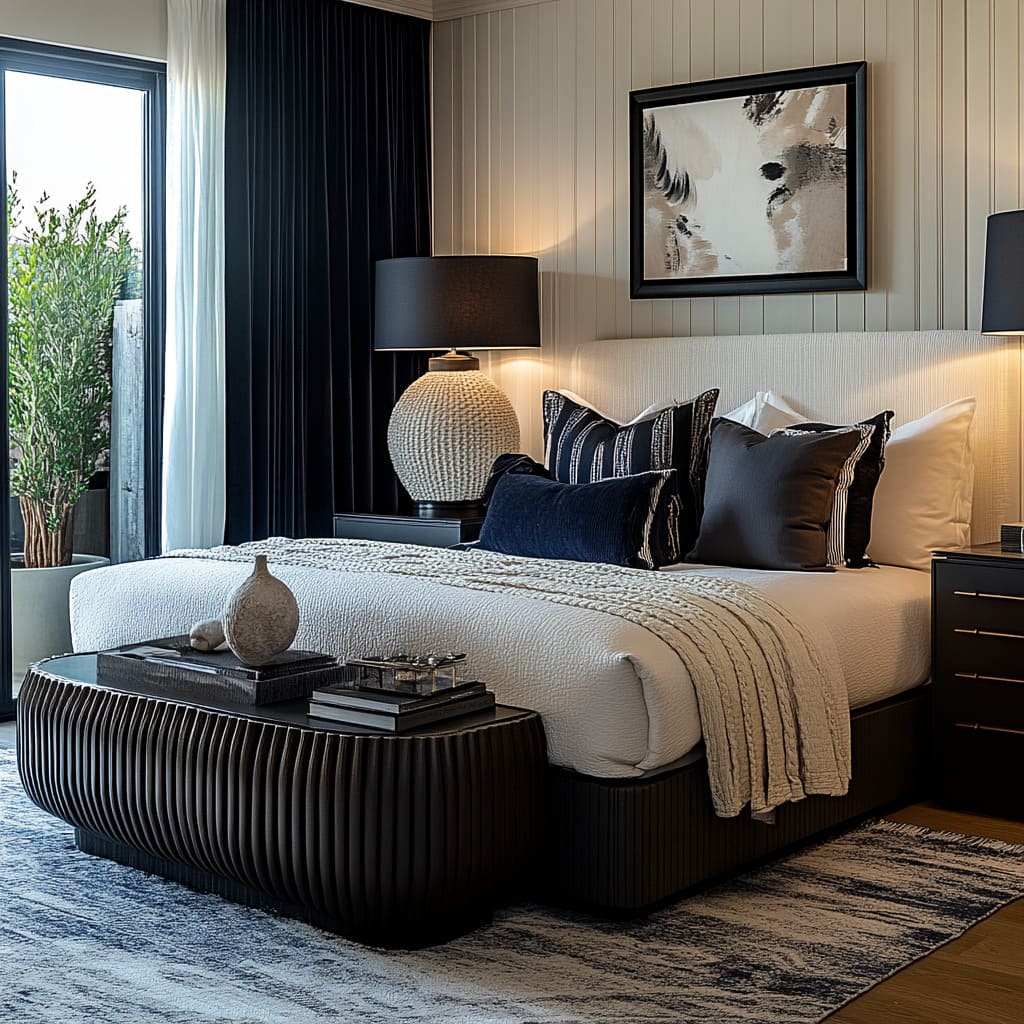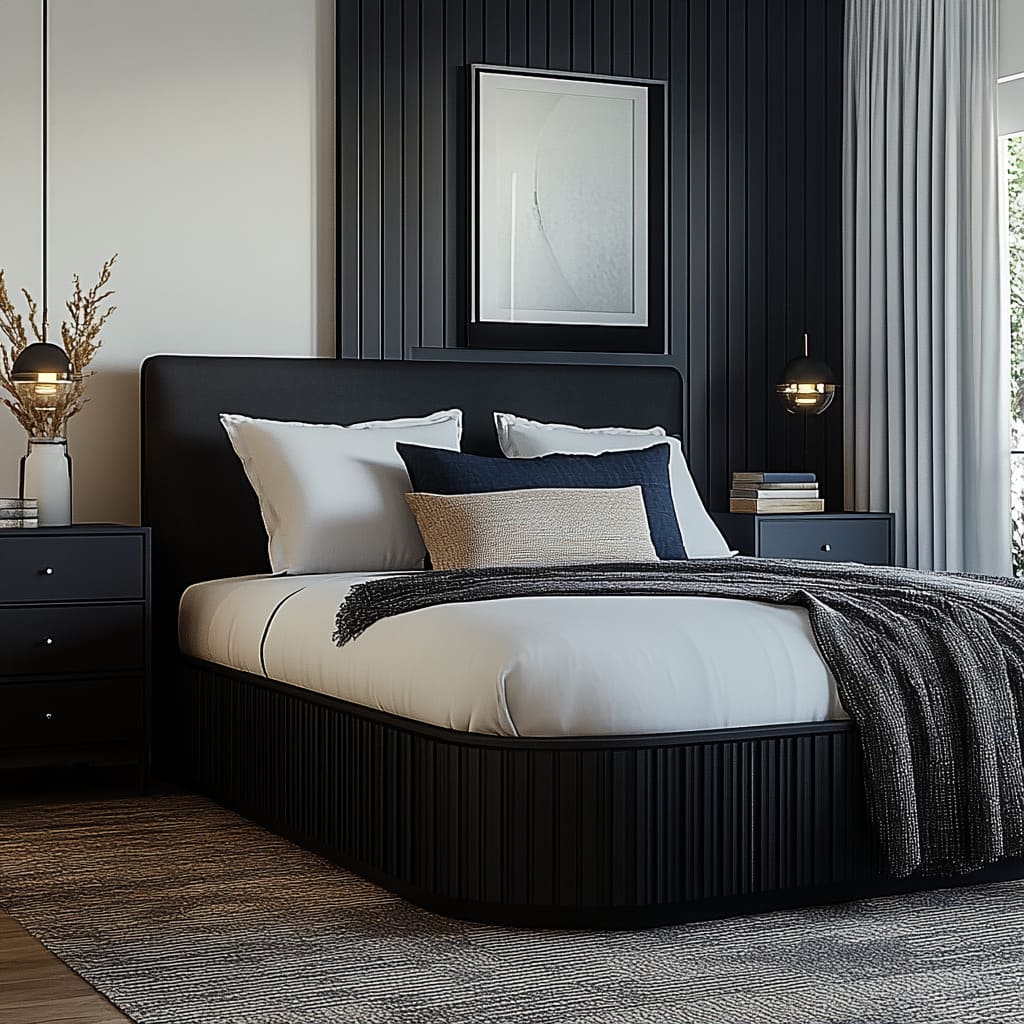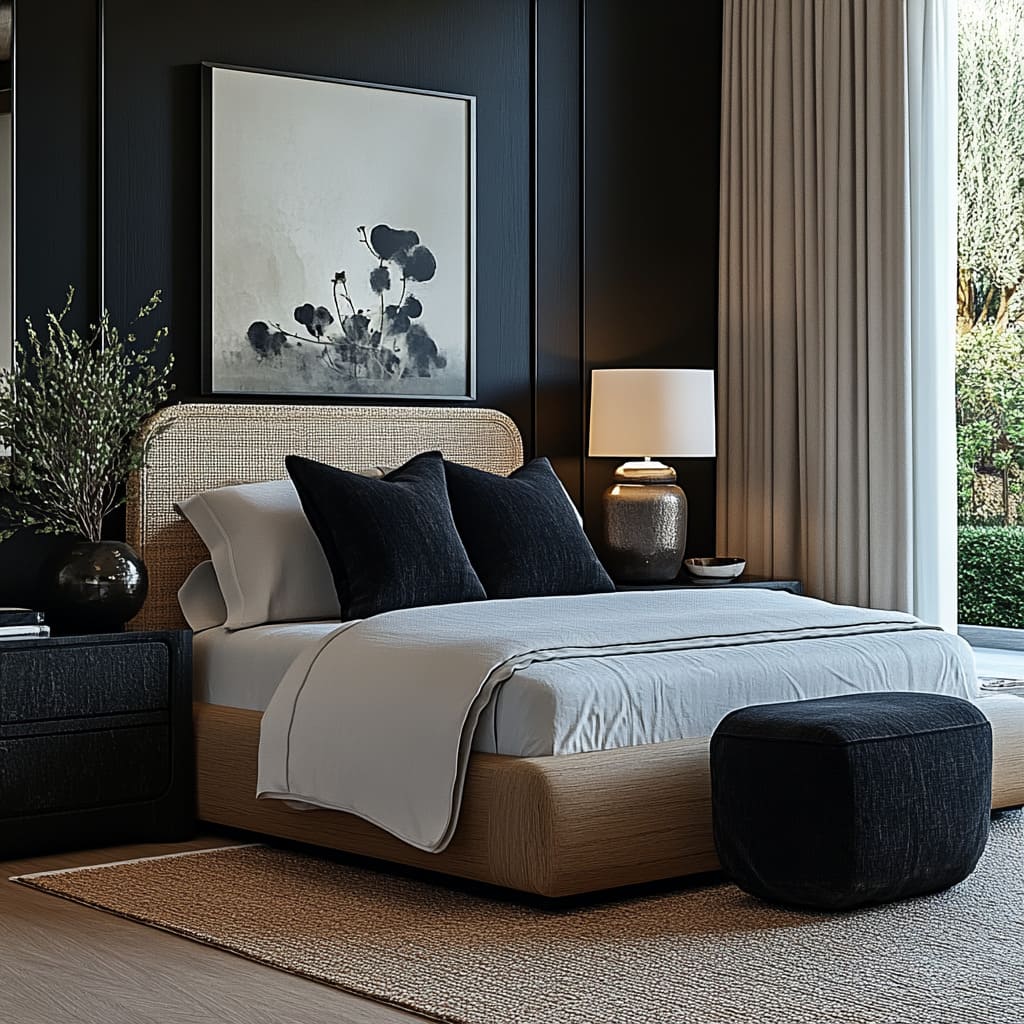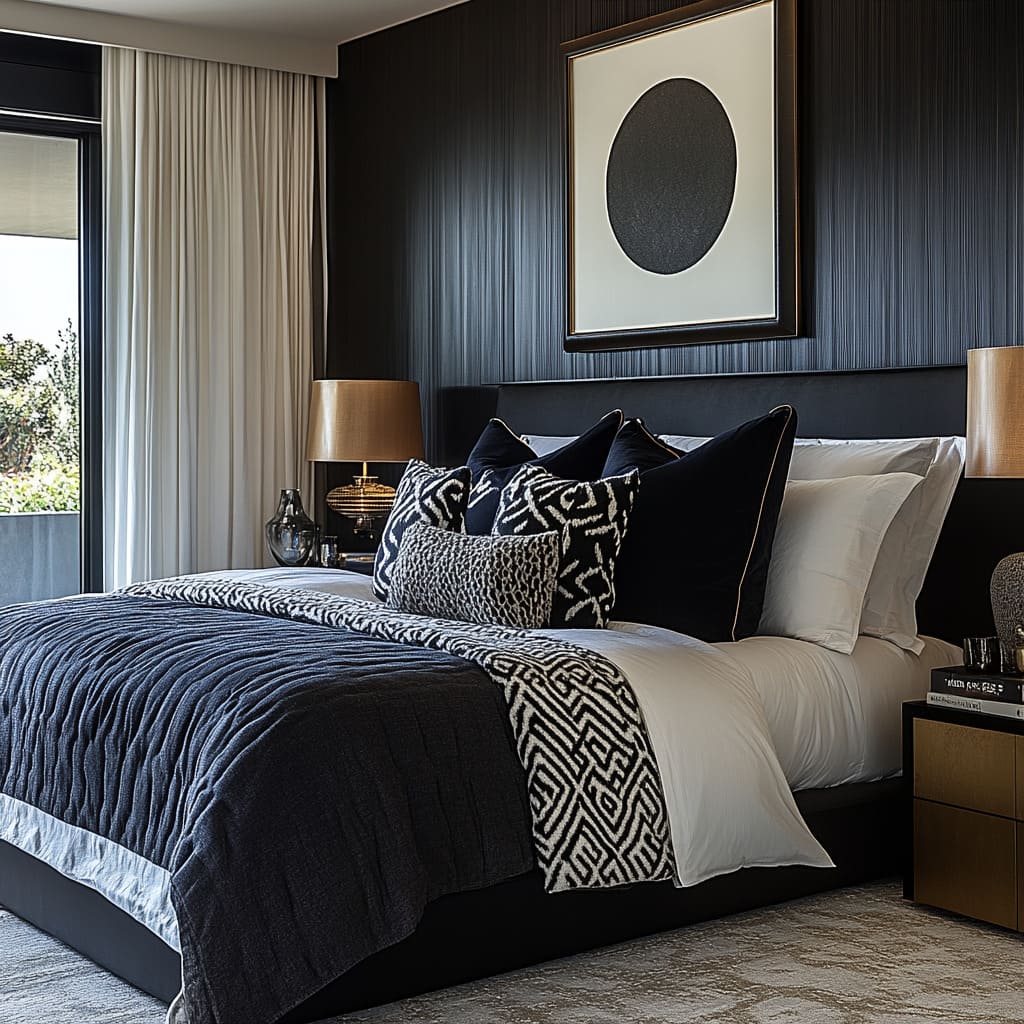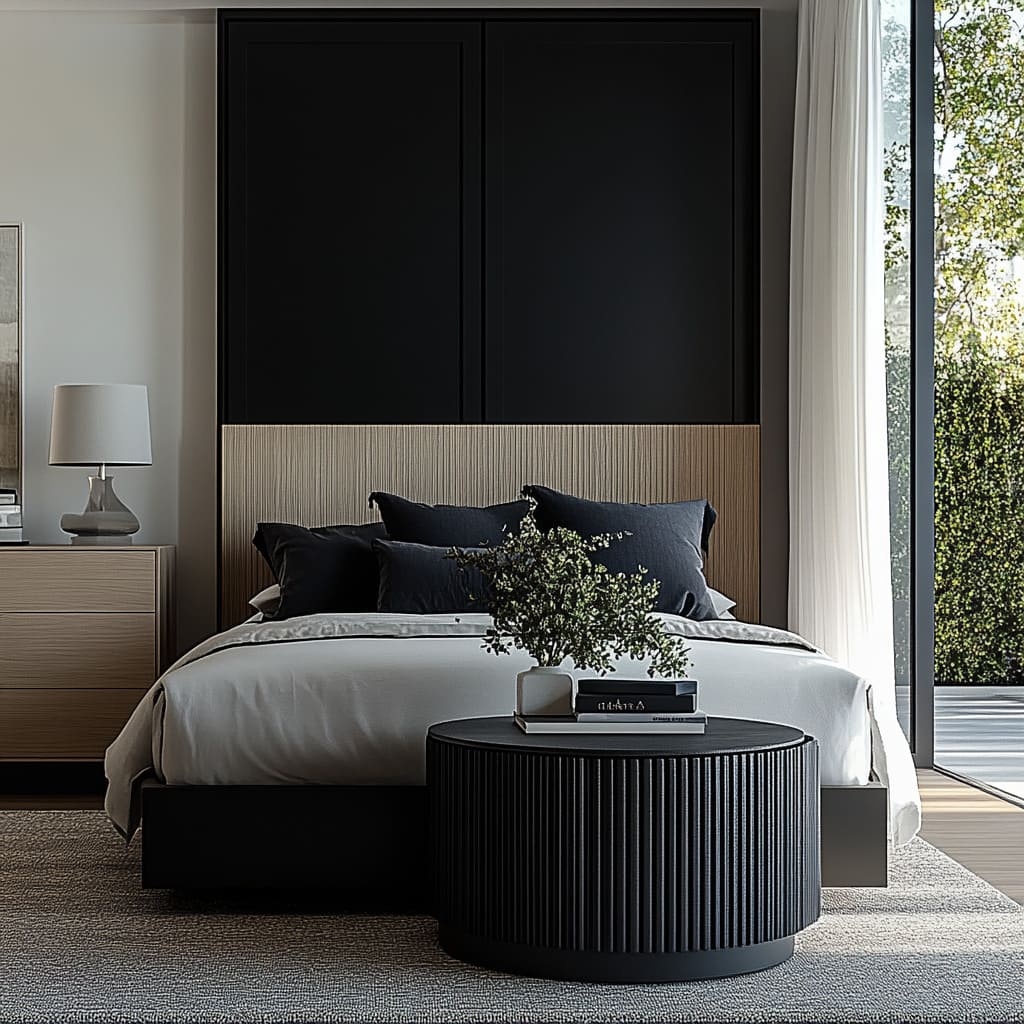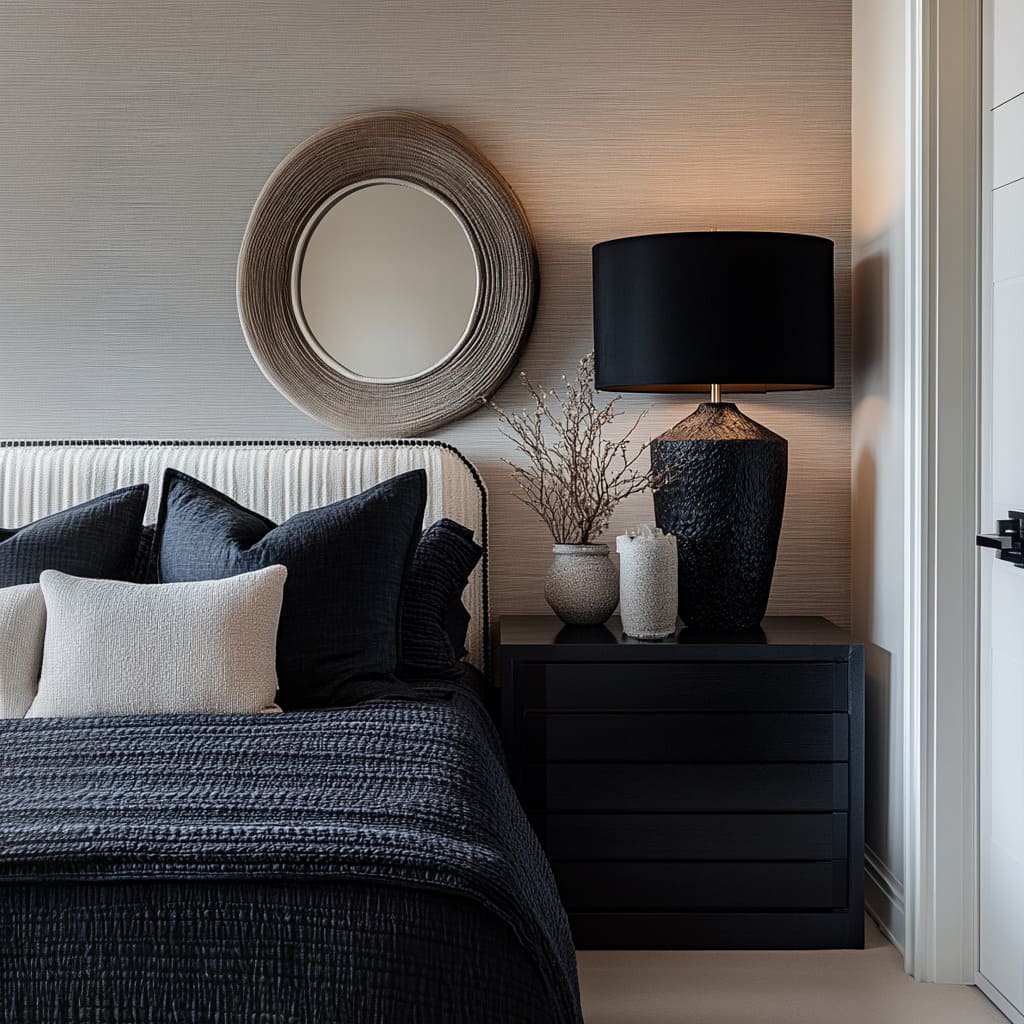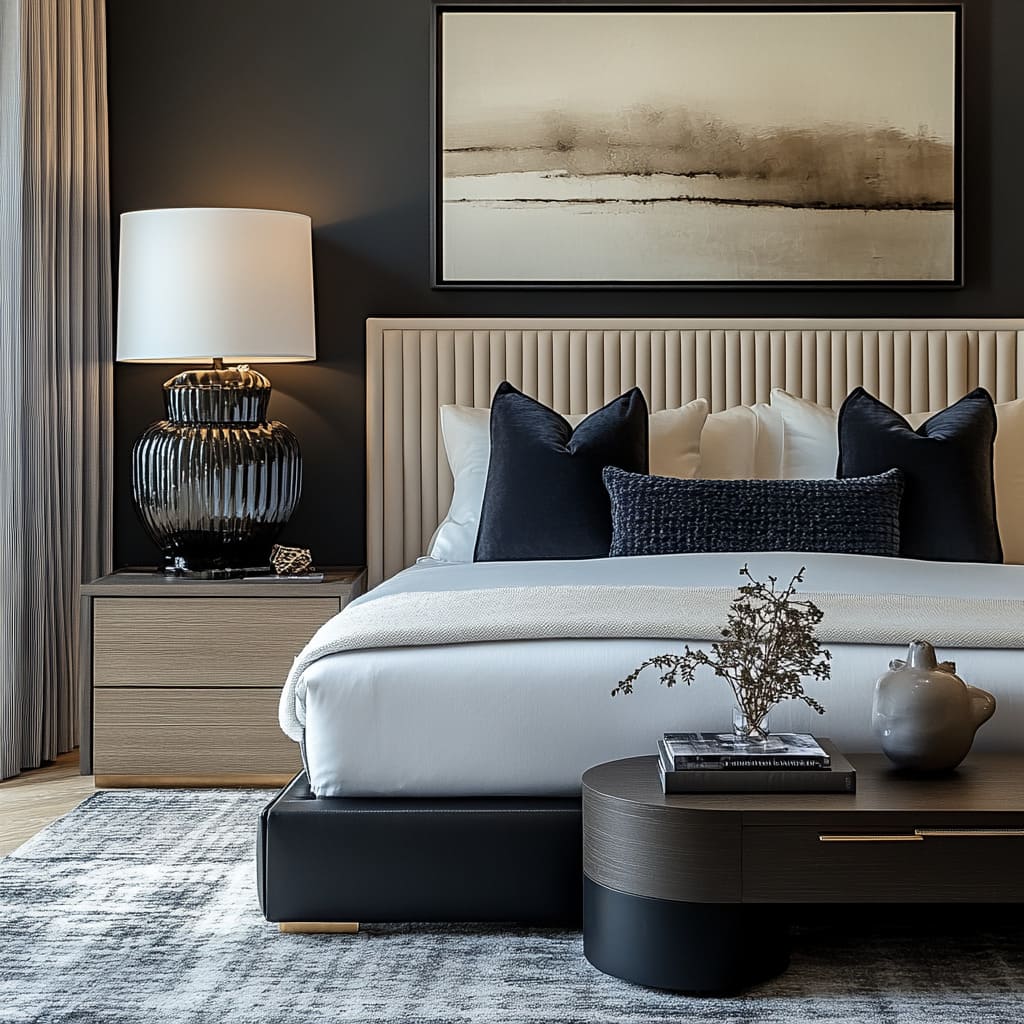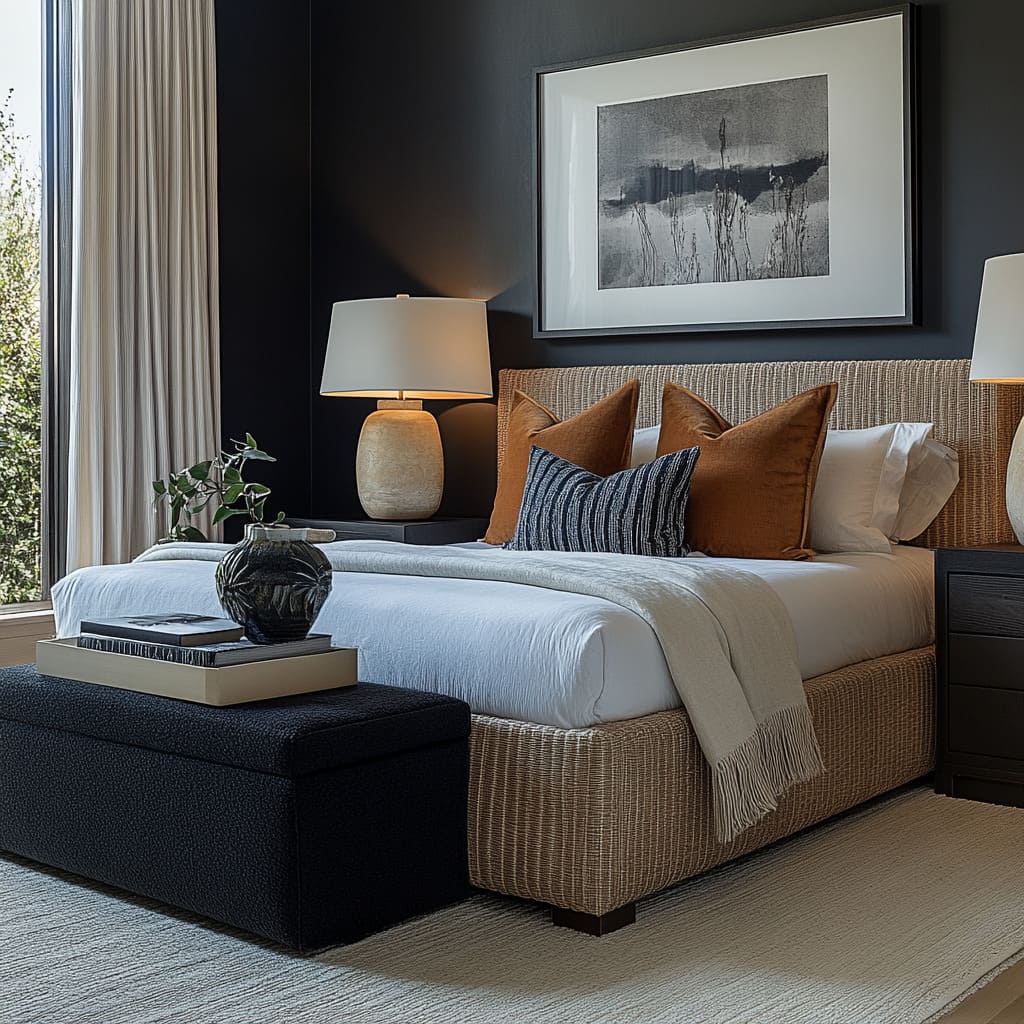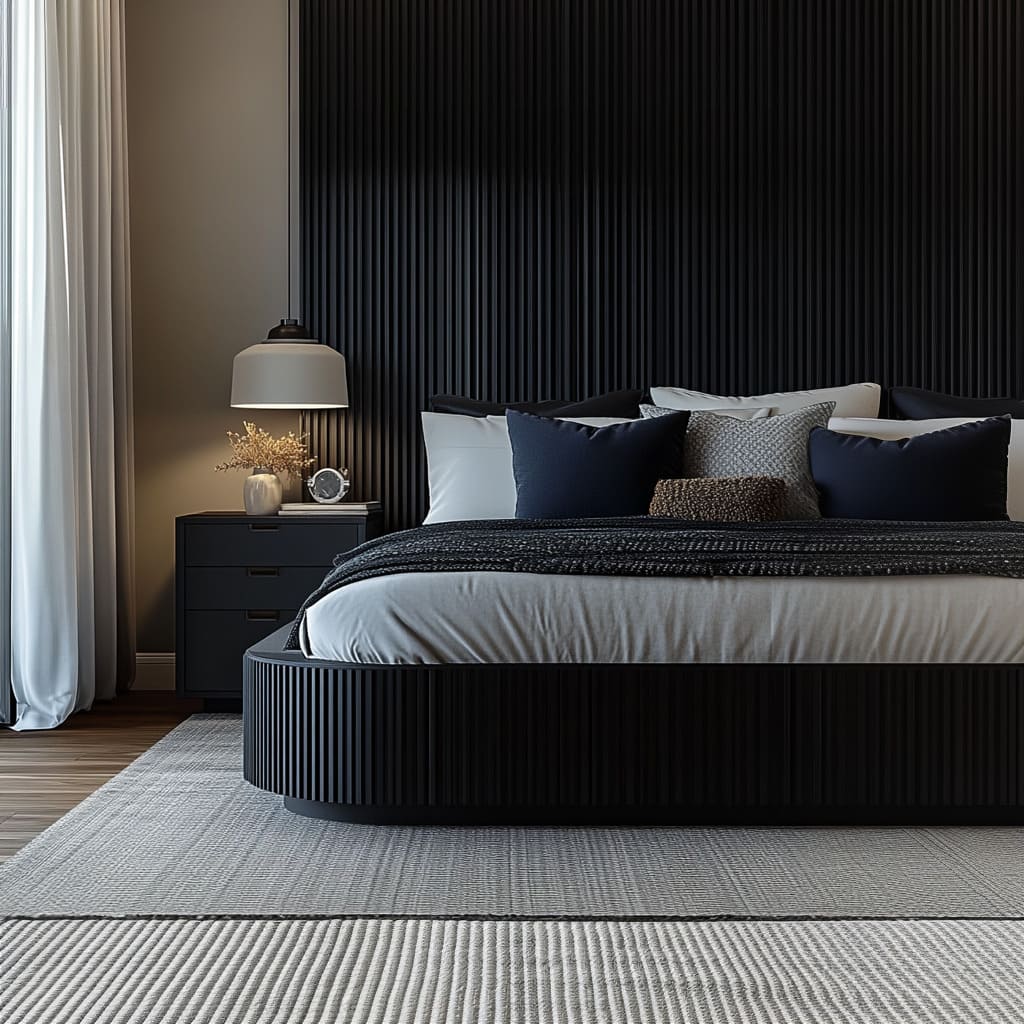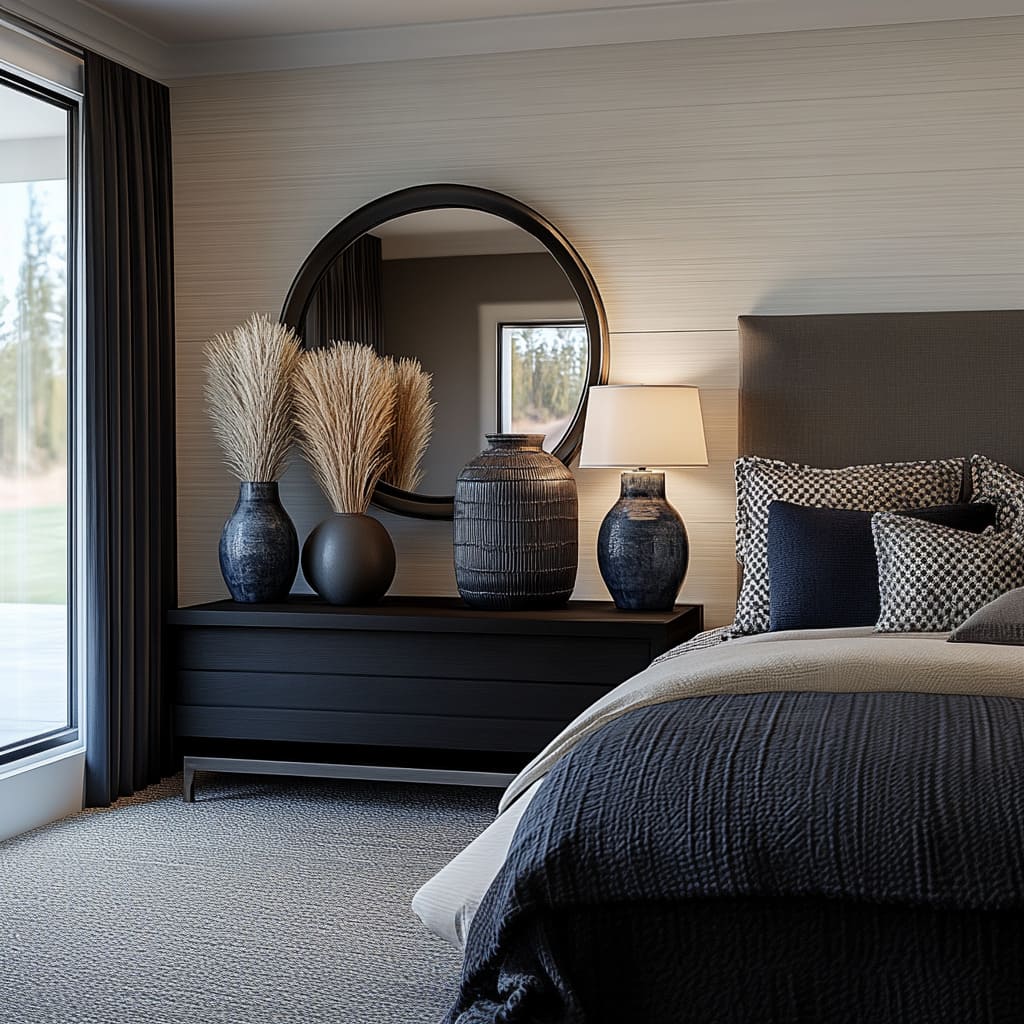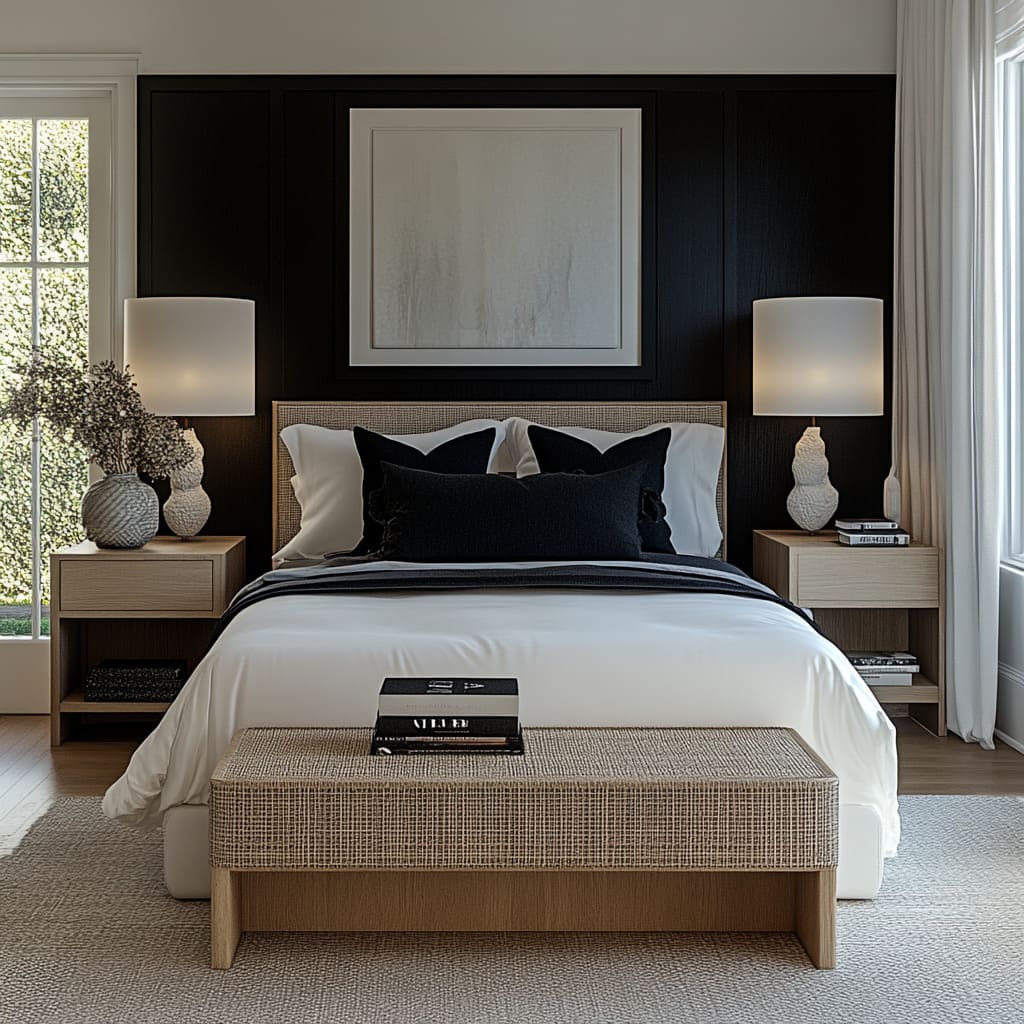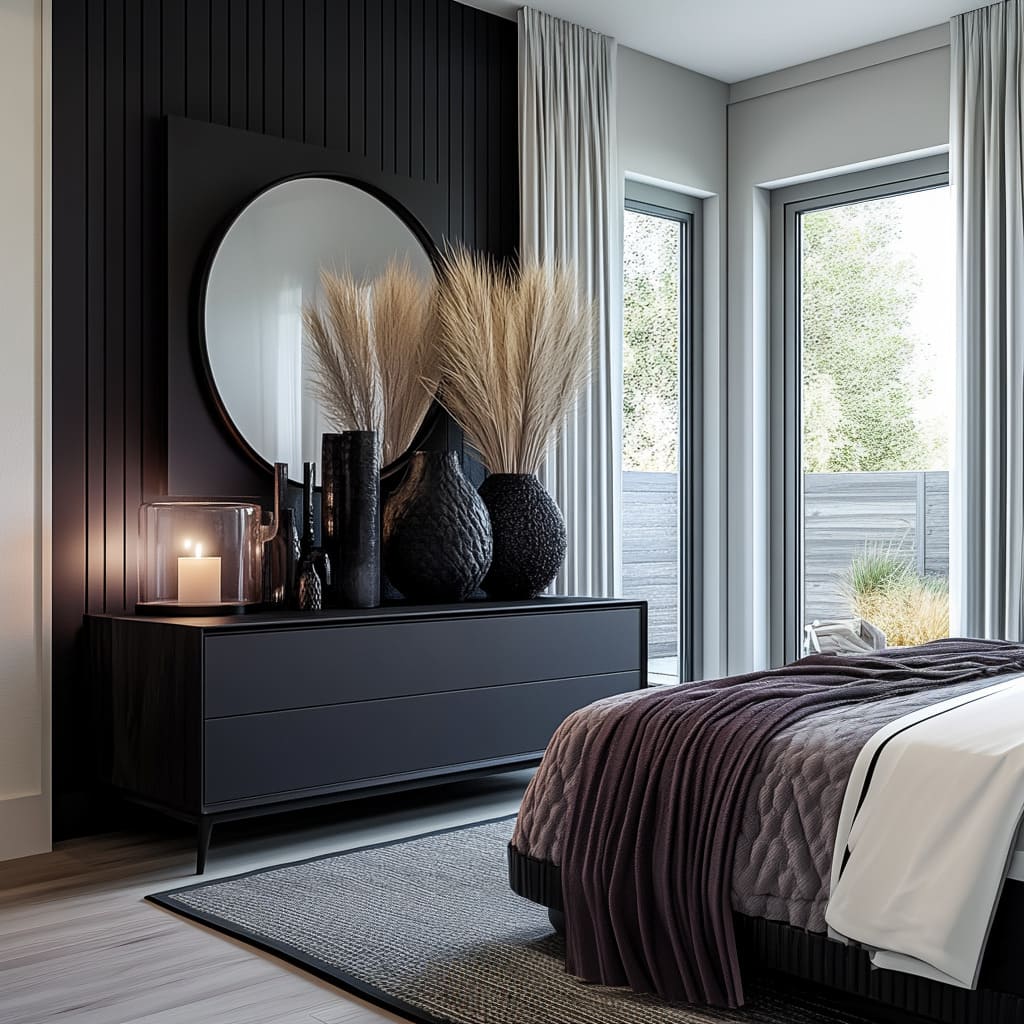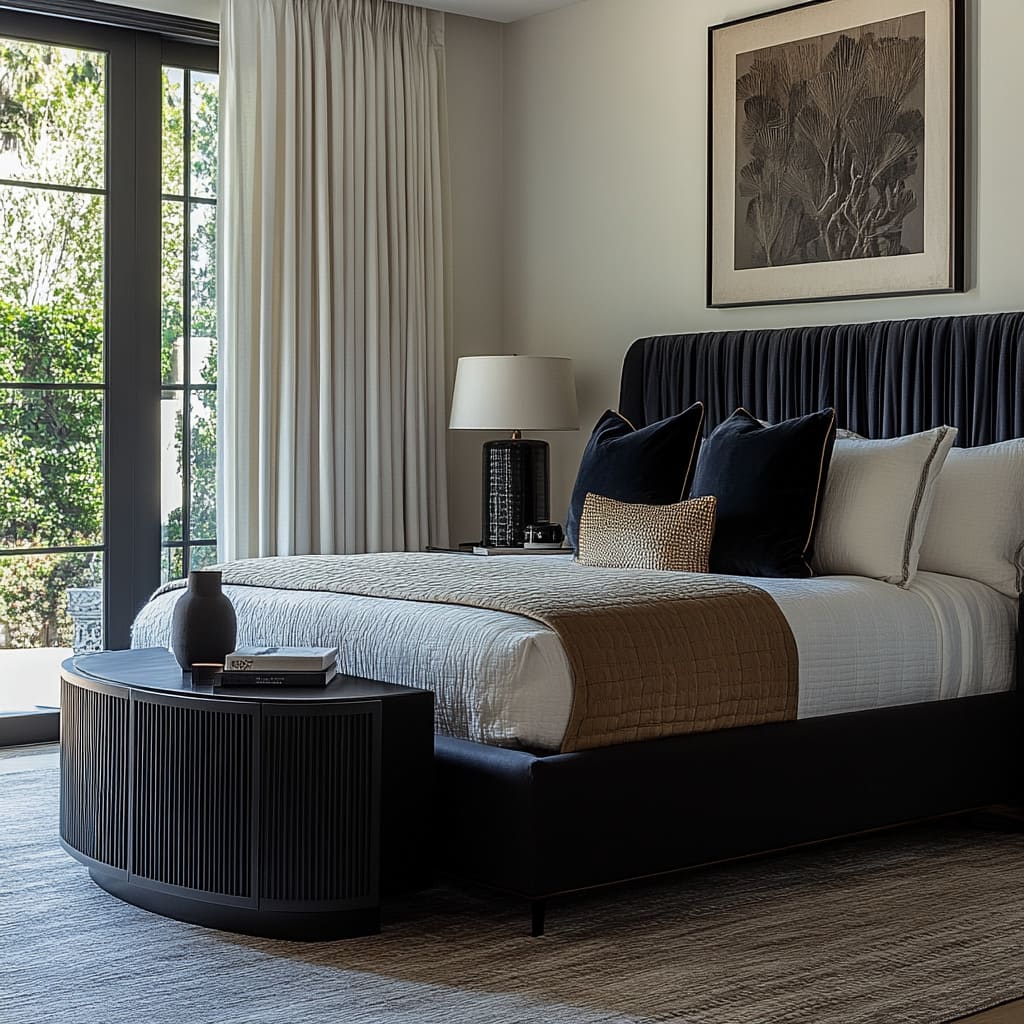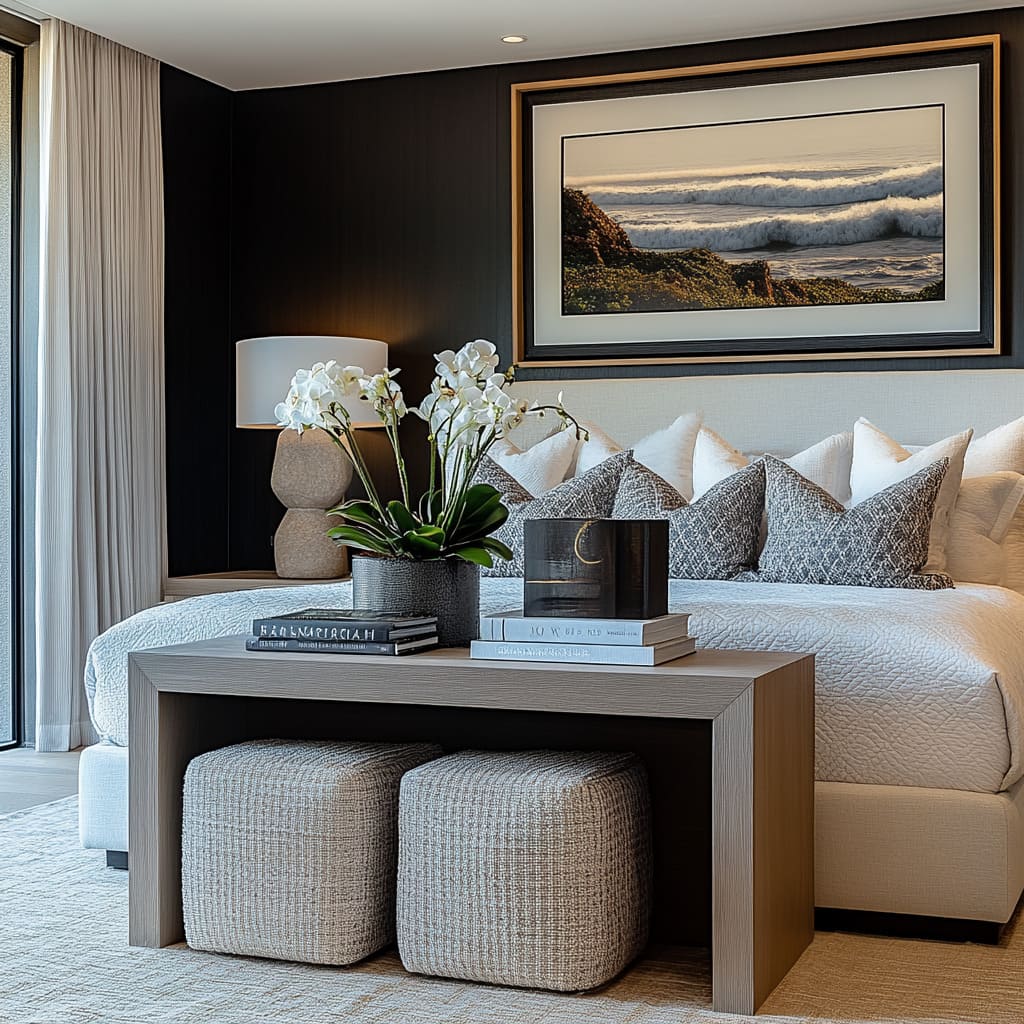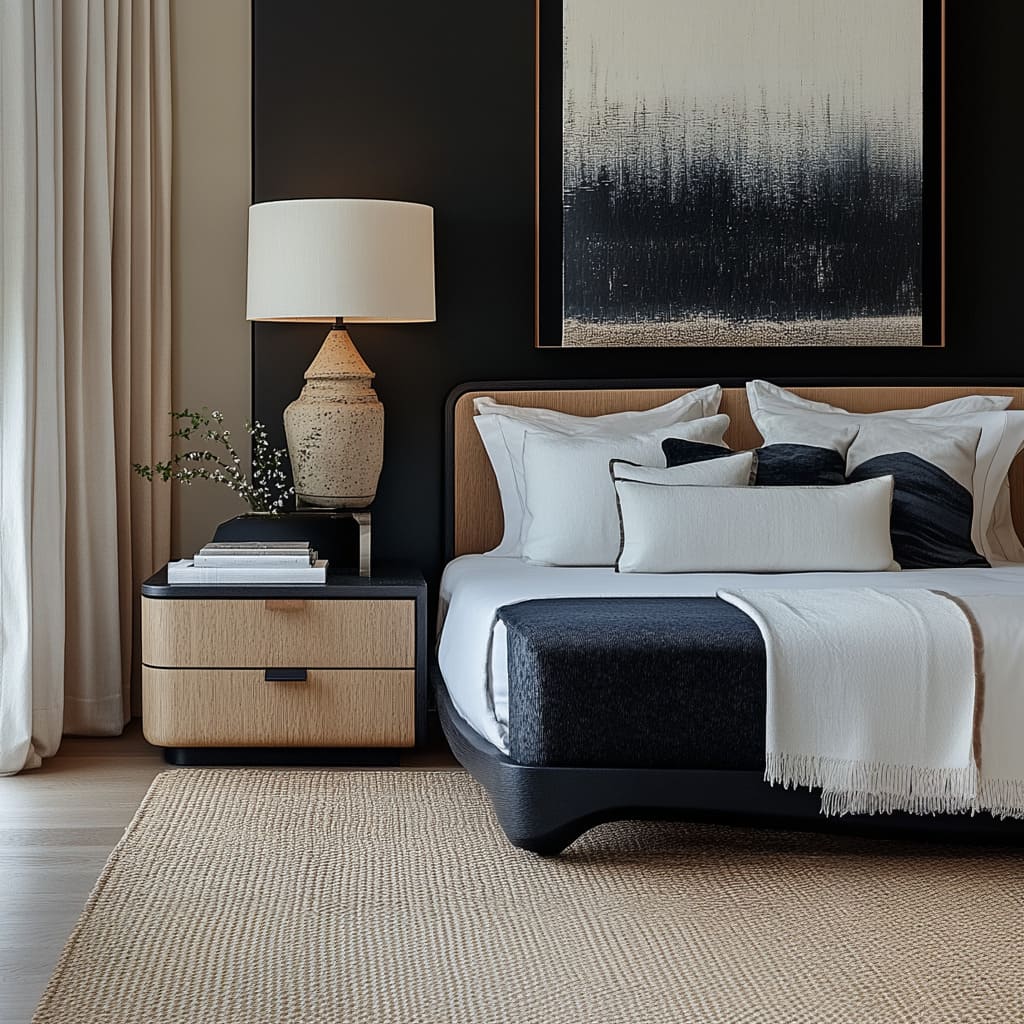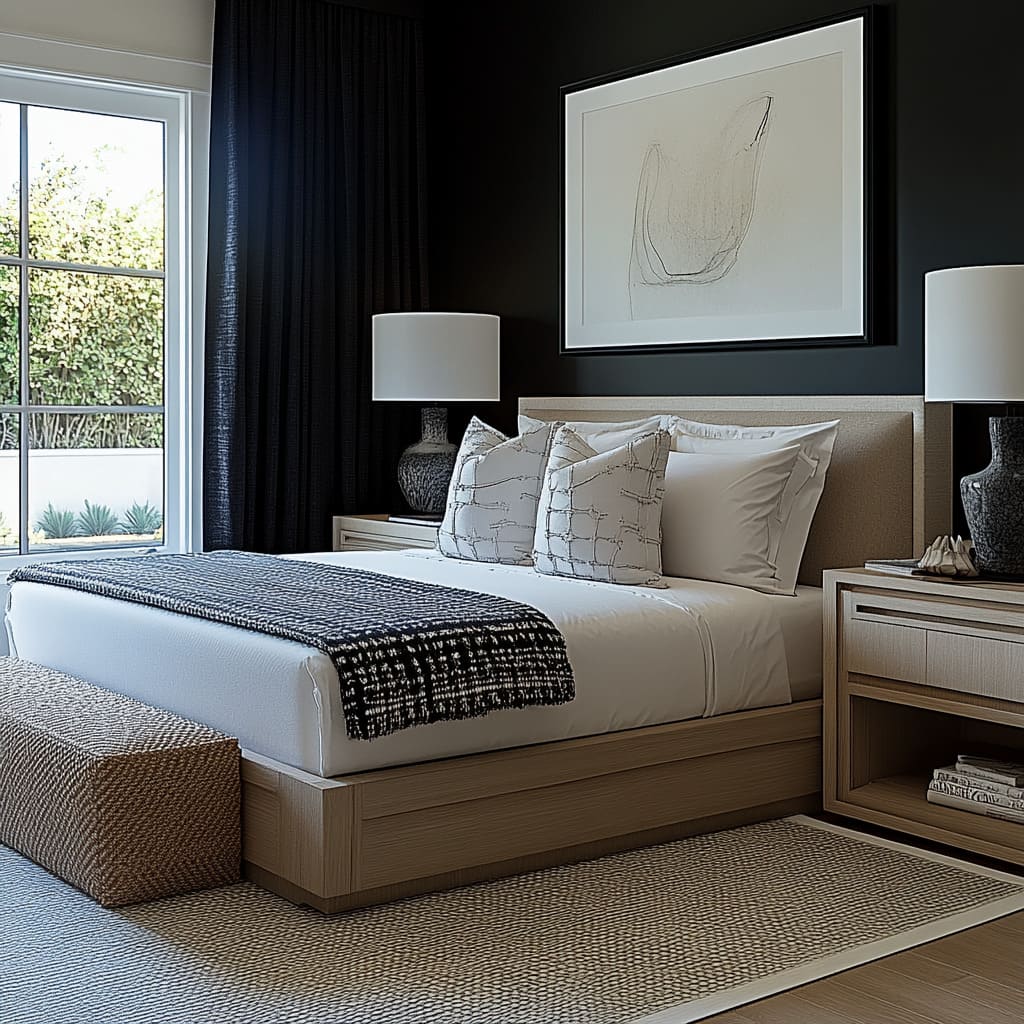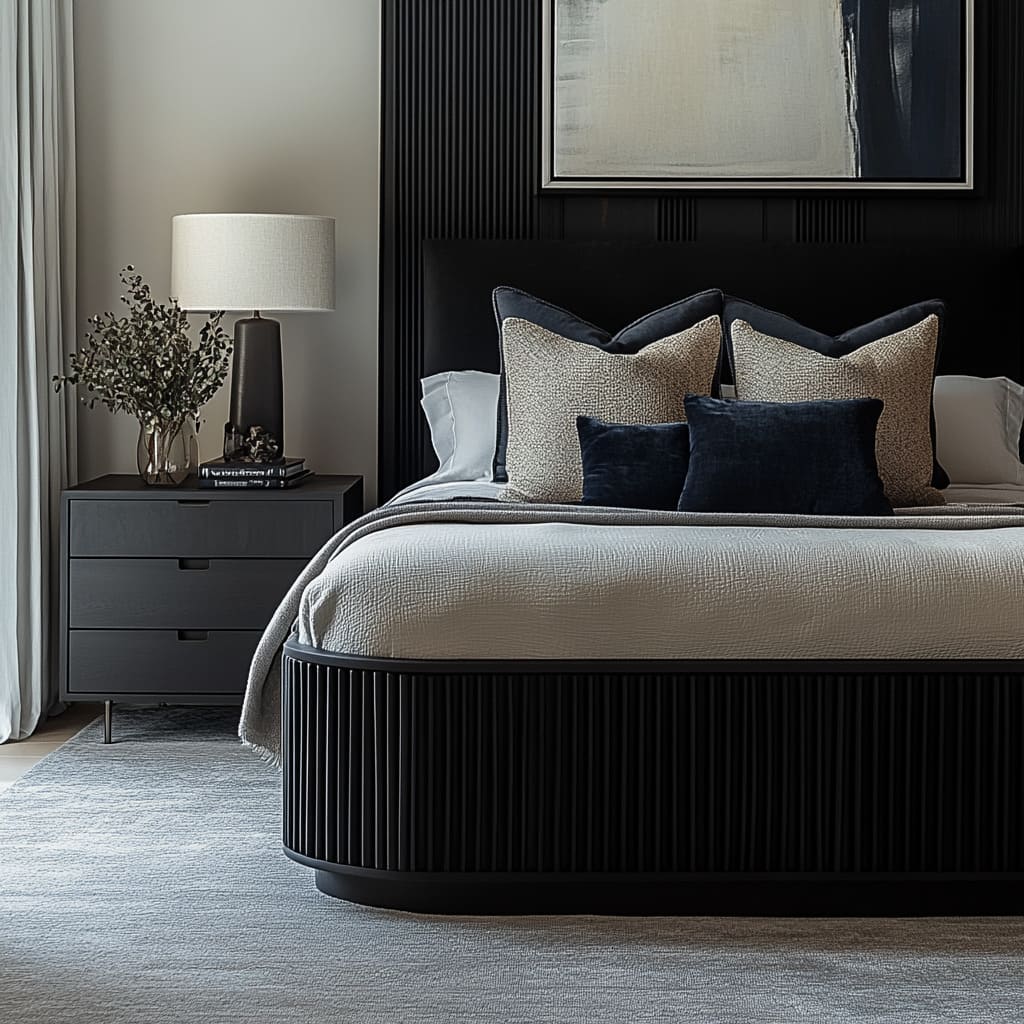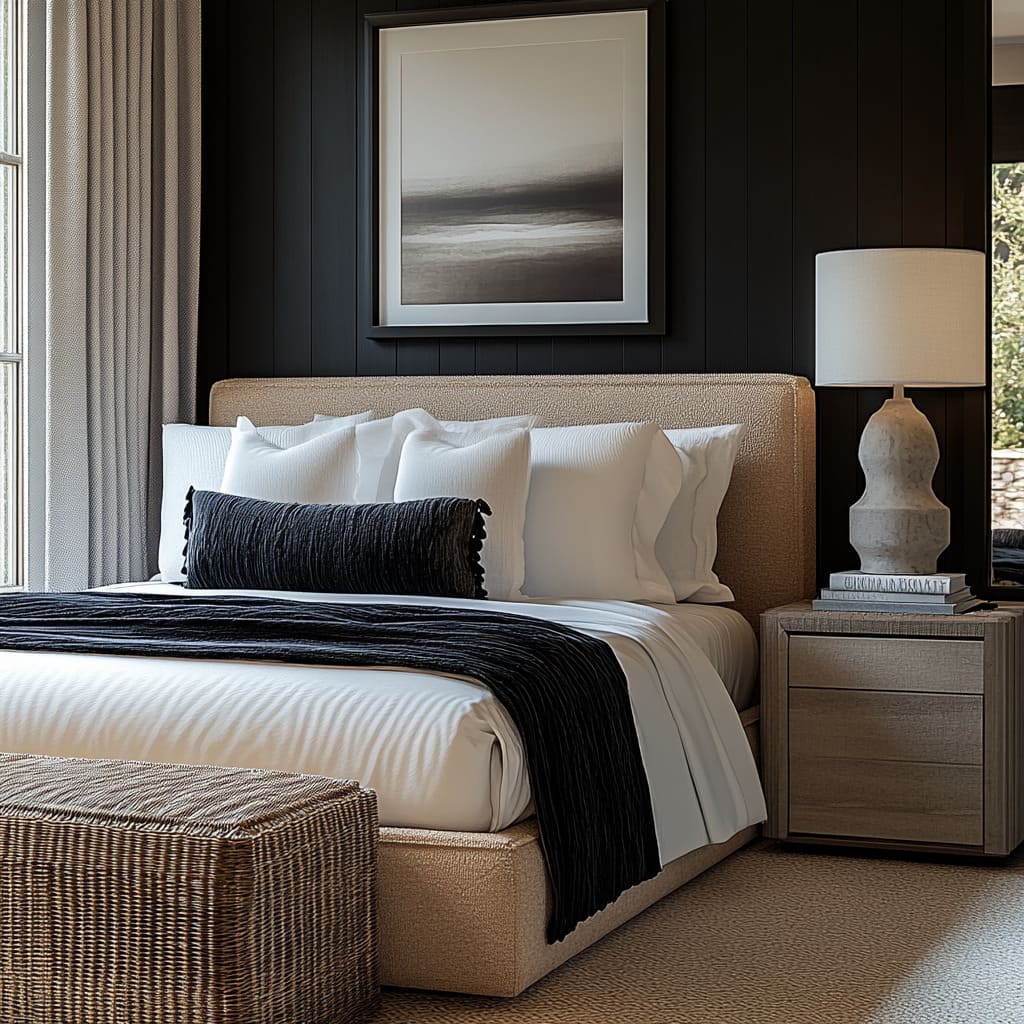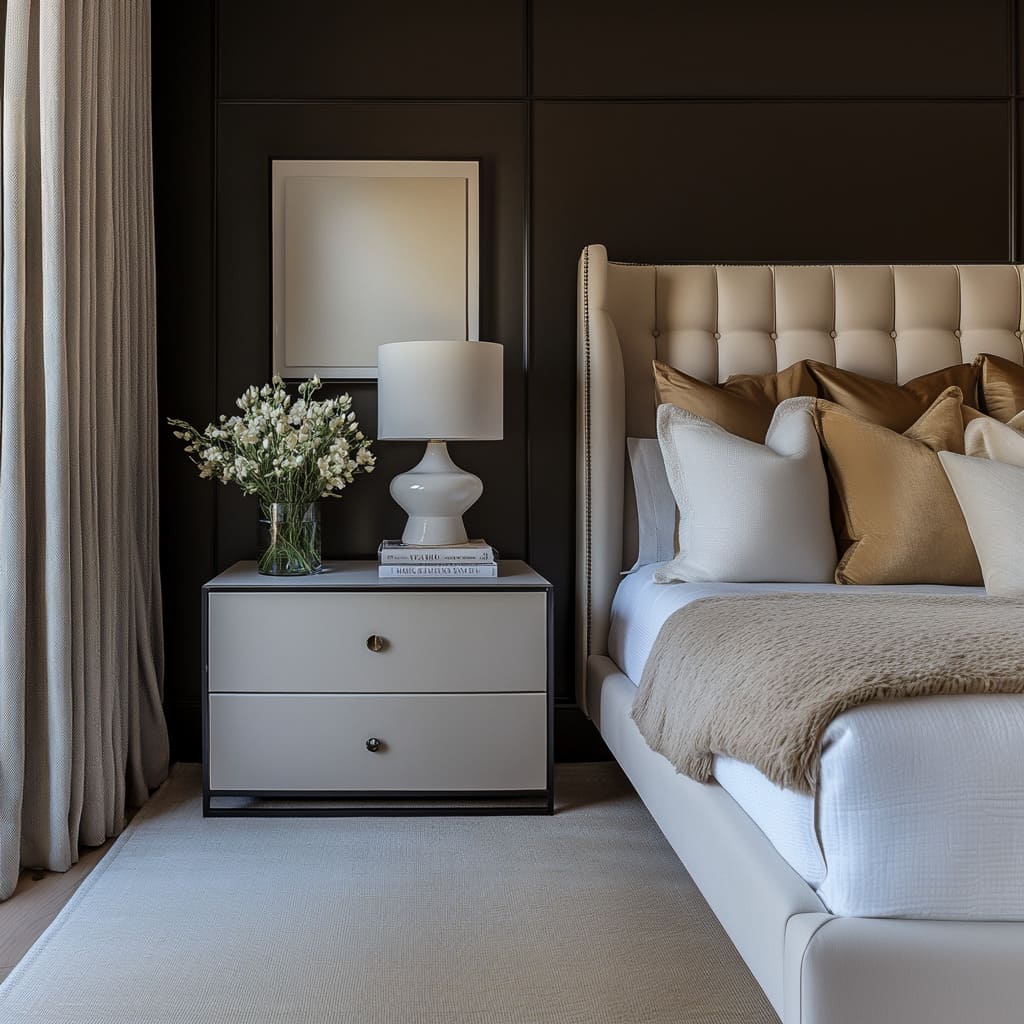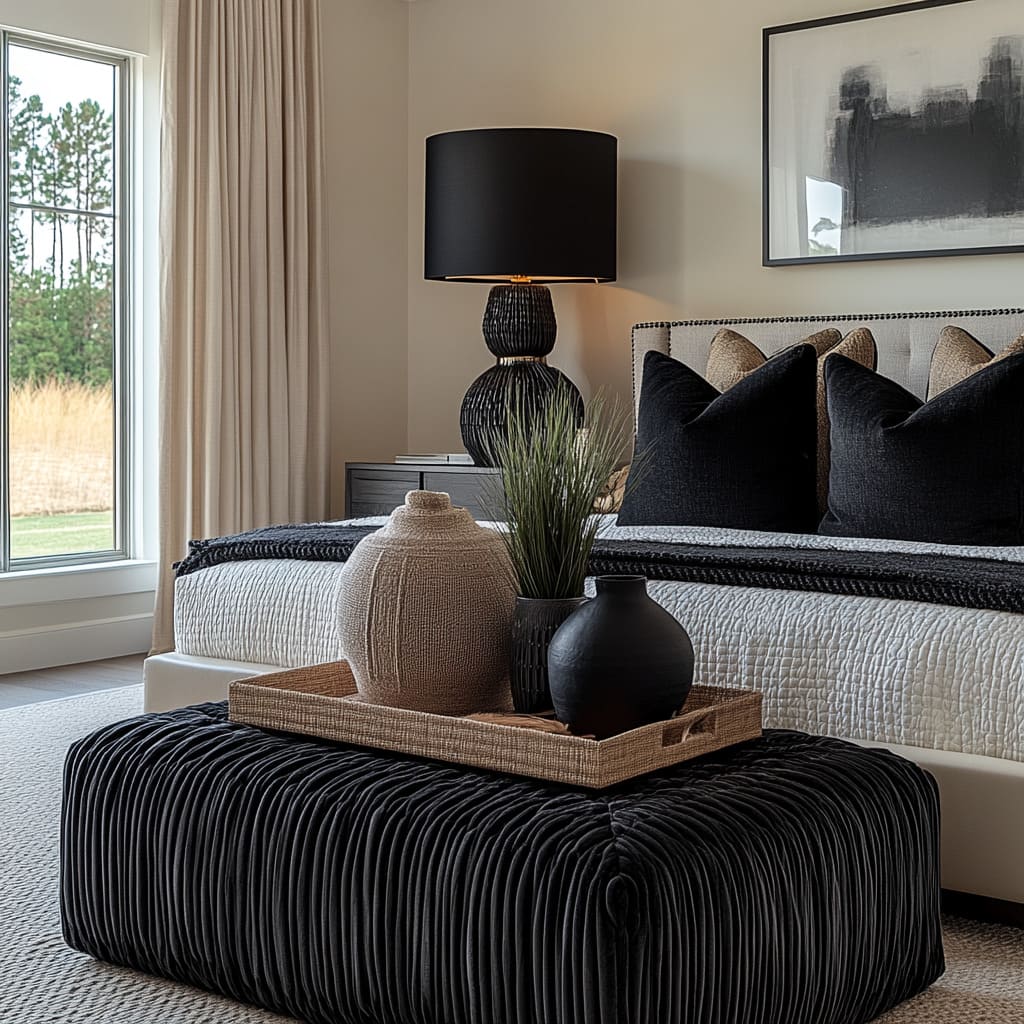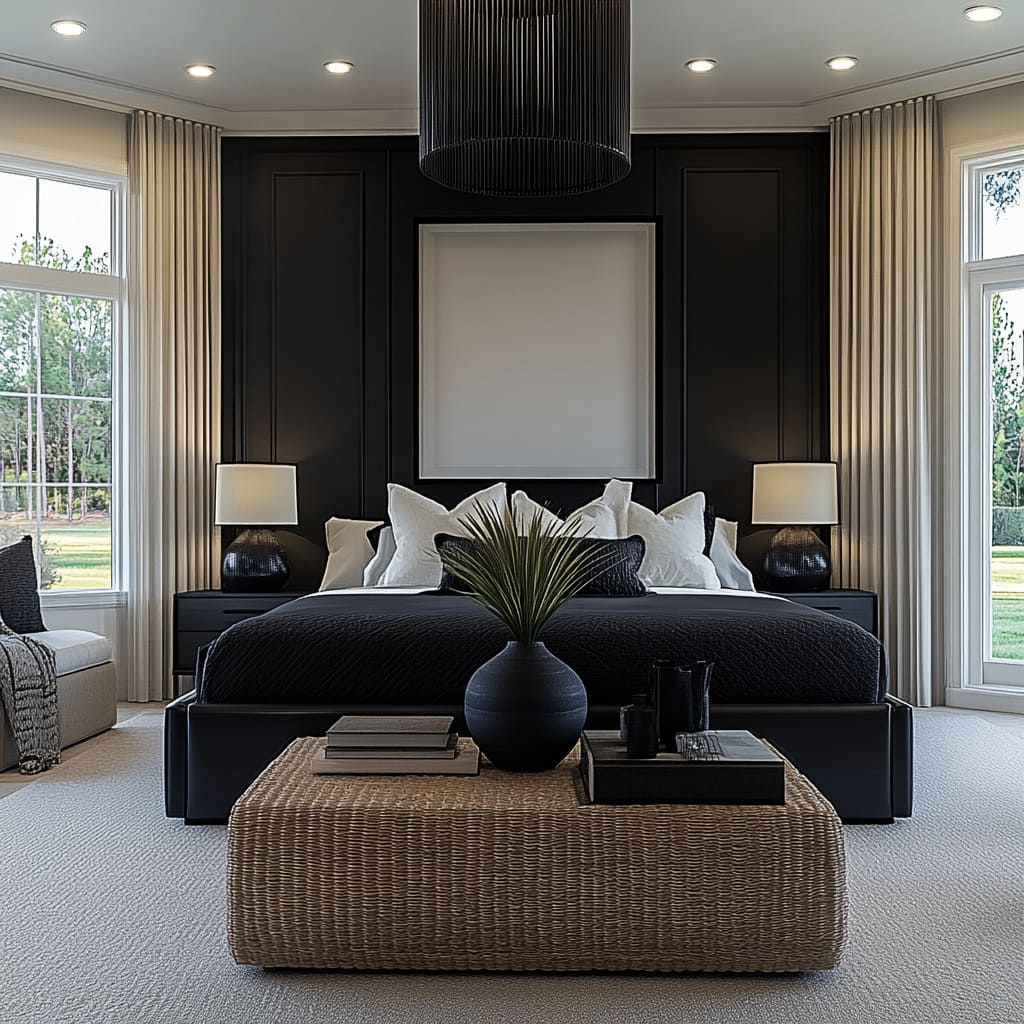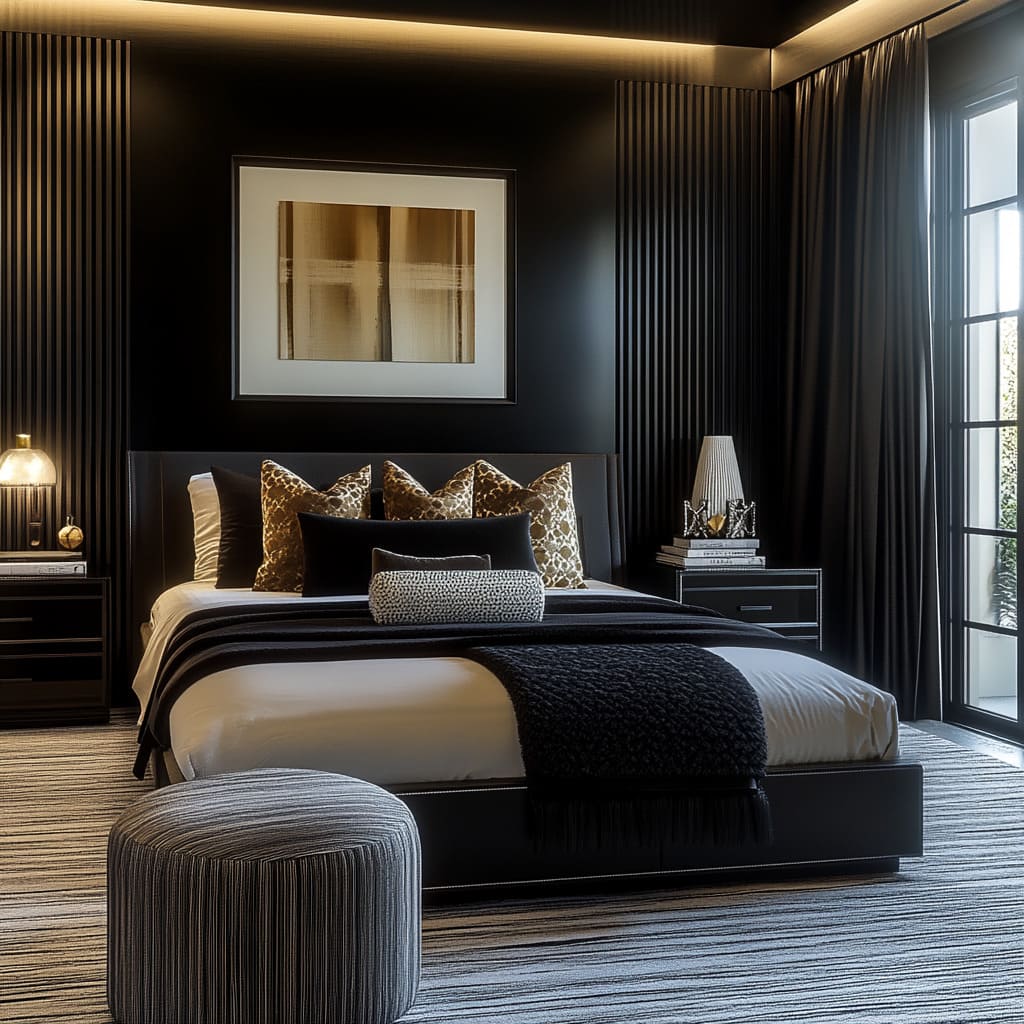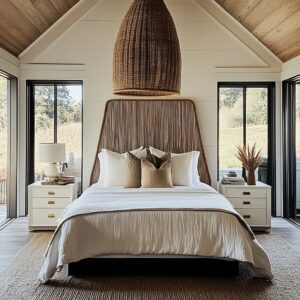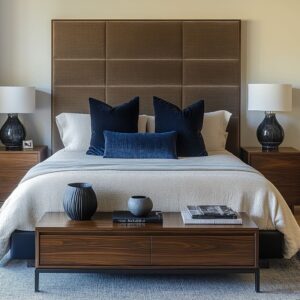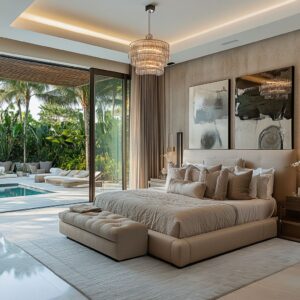Designing a black bedroom can seem like a bold move, but when done thoughtfully, it creates a space that is both dramatic and inviting. The key lies in achieving balance, ensuring the darker tones don’t dominate or make the room feel too heavy.
By blending contrasting materials, natural elements, and careful lighting choices, a black bedroom can be stylish, functional, and comfortable all at once. Here are some practical black bedroom design ideas to help you create the perfect look while maintaining harmony.
Strategic Use of Black as an Accent or Background
Black can transform a bedroom into a space of sophistication and depth when used thoughtfully, ensuring it supports the design rather than overpowering it. By employing black as a backdrop or as accent pieces, designers achieve balance and contrast, creating visually appealing interiors that are both cozy and striking.
Below are key insights and ideas for incorporating black seamlessly into bedroom design.
Black Walls as a Backdrop
One of the most effective strategies in black-decorated bedrooms is using black walls to anchor the design. This approach works best when the walls are complemented with lighter furniture and decor, ensuring the space remains balanced.
For example, a black wall with vertical paneling introduces texture and dimension, preventing the design from feeling too flat or overwhelming. The vertical lines guide the eye upward, giving the room a sense of height and sophistication while maintaining a cohesive look.
Pairing these walls with lighter headboards and bedding not only contrasts beautifully but also ensures a sense of airiness amidst the darker tones.
Non-Trivial Idea: Textured Black Walls
Adding texture to black walls, such as through paneling or subtle finishes, creates a layered effect that enhances depth without introducing heaviness. Smooth matte finishes for walls are complemented by glossy or wood-paneled accents, giving the room an engaging tactile quality.
This technique ensures that black becomes an integral part of the design rather than just a color choice.
Black Furniture as Key Accents
Black bedroom furniture ideas often revolve around incorporating bold yet minimalistic pieces to ground the space. Items like sleek headboards, nightstands, or a modern bench bring a sense of structure and stability to the room.
For instance, a curved black ottoman at the foot of the bed introduces a softer form to balance the otherwise sharp and linear elements. The curvature not only reduces visual weight but also adds a welcoming and approachable touch to the design.
Curved Forms to Soften Black Accents
Insightful use of shapes plays a crucial role in black bedroom interiors. Rounded or organic forms in furniture, such as oval mirrors or gently curved benches, offer a soft contrast to the boldness of black.
This thoughtful addition of fluid lines ensures the space doesn’t feel rigid or stark, enhancing its livability and charm.
Creating Contrast with Black Accents
When black is used for key furniture pieces, its impact is amplified by the surrounding lighter tones. A black headboard against a light-textured wall or a dark nightstand paired with a soft beige rug achieves a perfect interplay of light and dark.
This approach prevents the room from feeling monochromatic while maintaining an intentional, curated aesthetic.
Black Paired with Subtle Hues
To avoid overpowering the design, black accents are often paired with muted or neutral hues like cream, taupe, or pale gray. This combination creates a seamless transition between dark and light, enhancing harmony in the space.
Adding subtle metallic details—such as a brushed gold lamp or silver knobs—introduces a touch of brightness without clashing with the overall scheme. With these strategies, incorporating black into bedroom design becomes a creative process of layering textures, balancing tones, and thoughtfully positioning accents.
These ideas not only highlight the versatility of black but also ensure the bedroom remains inviting, functional, and visually compelling.
Balancing Black with Contrasting Elements
Successfully designing a black bedroom requires a thoughtful balance of contrasting tones and textures to ensure the space feels inviting rather than heavy. By integrating lighter elements and strategically placing black, designers create interiors that are visually striking yet harmonious.
Here are some key approaches and insights into achieving this balance.
Layering with White and Neutral Tones
One of the most effective techniques to balance the depth of black is by layering it with crisp white and soft neutral tones. White bedding, for instance, acts as a refreshing contrast, instantly brightening the space and creating visual breathing room.
Neutral rugs in shades like beige or taupe provide a gentle foundation that complements the intensity of black while maintaining a cohesive design. Light wood flooring, with its natural grain and warm undertones, ties the darker and lighter elements together, making the room feel grounded and approachable.
Designer Combination: Beige, Jute, and Black
A particularly successful combination often seen in black room decorations is the pairing of black with natural materials like jute, linen, and light wood. For example, a black bed frame or paneled wall gains warmth and character when matched with a woven jute rug or beige ottoman.
This combination avoids harsh contrasts, creating a balanced palette that feels natural and cohesive. These materials soften the boldness of black, making the room feel inviting rather than stark.
Strategic Placement of Black
Placement plays a critical role in how black elements interact with the rest of the room. Designers often confine black to specific areas, such as wall paneling, furniture bases, or accent pieces, rather than saturating the entire space.
This creates focal points that draw the eye without overwhelming it. For instance, black paneling on one wall can anchor the space, while lighter curtains, artwork, or decor above guide the eye upwards, ensuring the room retains a sense of openness and height.
Balancing Color Schemes with Art and Decor
Art and decor further enhance black bedroom color schemes by introducing softer tones and complementary hues. Abstract artwork in muted grays or whites, paired with black frames, seamlessly ties together the darker and lighter elements.
Light-colored vases, books, or greenery placed on black furniture break up the visual weight and add dimension. These carefully chosen accents prevent the design from feeling flat, ensuring a layered and dynamic aesthetic.
The Power of Light and Shadow
Lighting is another critical factor in balancing black. Soft, warm lighting, whether from bedside lamps or pendant fixtures, creates a cozy glow that offsets the depth of black.
Sheer curtains allow natural light to filter in, brightening the space while adding a soft contrast to dark tones. Together, light and shadow play a significant role in defining the mood and ensuring balance.
Textures to Break the Monotony
To avoid monotony, textures are layered across the room, introducing tactile interest. Quilted bedding, woven rugs, and smooth black furniture create a multi-dimensional design that engages the senses.
This careful interplay of textures ensures that black elements feel integrated into the design rather than dominating it. By blending light and dark elements, strategically placing black accents, and incorporating natural materials, designers transform black bedrooms into spaces that are as dynamic as they are relaxing.
These principles not only showcase the versatility of black but also demonstrate how thoughtful design choices can make a bold color feel perfectly balanced.
Textural and Material Play
The success of a black bedroom often hinges on the strategic use of textures and materials to create a visually engaging and comfortable environment. Textures not only add depth but also bring an inviting warmth to what could otherwise feel stark or heavy.
Here’s how materials and layering elevate black bed design ideas into rich, sophisticated spaces.
Incorporating Natural Textures
Natural materials such as rattan, jute, and woven fabrics introduce an organic warmth that softens the boldness of black. These textures create balance by adding an earthy touch, making the overall design feel grounded and approachable.
For example, a woven rattan headboard paired with sleek black wall paneling creates a modern yet organic vibe, blending two distinct styles seamlessly. This approach highlights how natural textures can complement darker tones without competing with them.
Blending Bold and Organic Elements
One particularly effective strategy is the use of textured headboards in natural materials. A woven rattan headboard set against black panel walls offers a striking combination, where the softness of the rattan balances the depth of the walls.
This blend of bold and natural design languages avoids visual monotony, ensuring the room feels dynamic yet cohesive.
Layering Textures for Depth
Layering textures is key to achieving a dynamic interior. Quilted bedding, plush velvet pillows, and smooth leather benches all contribute to a rich variety of tactile elements within the room.
These layers ensure that even a limited color palette feels vibrant and engaging. For instance, a black quilted bedspread combined with velvet accent pillows not only adds depth but also enhances the room’s overall comfort and luxury.
Idea: Subtle Textures in Black Elements
Textured black elements, such as a woven ottoman or a bedspread with intricate quilting, introduce subtle dimension without the need for additional colors. These details ensure that black bedroom accents stand out while maintaining harmony within the monochromatic palette.
This approach works particularly well in minimalist designs, where every element must contribute meaningfully to the overall aesthetic.
Materials as Functional and Visual Features
Natural textures and materials also serve functional purposes in these designs. A jute rug not only adds warmth underfoot but also visually softens the contrast between black furniture and lighter flooring.
Similarly, leather benches or chairs provide durability while contributing to the room’s overall polished look. This dual-purpose use of materials ensures that aesthetics and practicality coexist seamlessly.
Balancing Texture and Light
Lighting plays a pivotal role in enhancing the interplay of textures. A soft, warm glow from bedside lamps or pendant lights highlights the intricate details of woven materials and quilted fabrics.
This interaction between texture and light creates a layered ambiance, ensuring that darker elements feel inviting rather than overpowering. Incorporating varied textures into a black bedroom design allows for a dynamic and comfortable space.
By blending natural materials like rattan and jute with rich layers of velvet and leather, designers achieve a balance that feels luxurious yet approachable. These thoughtful touches turn bold black elements into a cohesive and engaging design statement.
Lighting as a Balancing Tool
Lighting plays a pivotal role in the design of black bedrooms, subtly offsetting the depth and boldness of dark hues to create a harmonious and inviting ambiance. The interplay of natural and artificial light ensures that even spaces dominated by darker tones remain balanced and visually appealing.
Warm Lighting to Soften Black
The use of warm lighting elements is a key strategy in black bedroom design. Lamps with soft gold or beige shades are frequently employed to diffuse light evenly, softening the boldness of black surfaces.
These warm tones counteract the intensity of black and provide a cozy glow that makes the space feel more approachable. Accent lighting, such as small bedside lamps or LED strips, is strategically positioned to highlight specific features like bedside tables or wall art, drawing the eye toward focal points and away from areas that might feel overly dark.
Idea: Reflective Finishes for Amplified Light
An innovative approach involves integrating reflective finishes, such as metallic lamp bases or glass vases, into the design. These elements catch and amplify light, enhancing brightness while adding a layer of sophistication.
For example, a lamp with a polished gold base not only emits warm light but also reflects its surroundings, reducing the visual heaviness of black furniture and walls.
Natural Light as a Counterbalance
Maximizing natural light is a fundamental principle in balancing darker interiors. Large windows, often extending from floor to ceiling, act as significant counterpoints to black-dominated spaces.
These openings are framed with sheer or light-colored curtains that allow sunlight to diffuse gently across the room. This approach ensures that the room remains bright and airy without diminishing the dramatic impact of the dark color palette.
Idea: Sheer Curtains for Light Diffusion
Sheer, floor-length curtains serve as an elegant yet functional choice in black bedrooms. Their light, flowing fabric softens the stark contrast between dark walls and windows, creating a seamless transition that enhances the room’s overall balance.
The interplay of light through sheer curtains adds a dynamic quality to the space, subtly shifting with the time of day.
Accent Lighting as a Design Highlight
Accent lighting isn’t merely functional but a deliberate design choice in these interiors. By placing warm, directional lights above headboards or under shelving, designers create zones of interest within the room.
This layered lighting scheme adds depth, ensuring the room feels visually engaging rather than flat. For instance, a softly lit painting on a black wall becomes a striking centerpiece, enhancing the drama without overpowering the space.
Black Light Bedroom Ideas in Action
When pairing black interiors with thoughtful lighting, the design moves from being simply bold to meticulously balanced. The inclusion of multiple light sources—both natural and artificial—ensures that the bedroom feels dynamic, welcoming, and comfortable.
Whether it’s the glow from a lamp with a metallic finish or sunlight filtering through sheer curtains, the balance of light and dark creates a timeless appeal. By leveraging a mix of lighting techniques, black bedrooms can exude warmth and depth without feeling overwhelming.
The thoughtful placement of warm lights, use of reflective finishes, and careful framing of natural light demonstrate how even the darkest interiors can achieve a perfect balance.
Functional and Decorative Accessories
Artwork as a Design Anchor
Artwork plays a pivotal role in balancing the boldness of black interiors while adding an essential decorative touch. Large abstract pieces, often in neutral or monochrome palettes, are strategically positioned above beds or on focal walls.
These pieces serve as visual anchors, breaking up the dominance of dark walls and introducing a sense of structure and character. The deliberate use of abstract forms complements the modern design of the rooms, creating a harmonious yet striking effect.
Idea: Statement Art That Unifies the Scheme
One effective approach involves choosing oversized artwork with black and white tones to seamlessly tie the room’s color palette together. This design choice ensures that the artwork enhances the decor without overpowering it.
For instance, a bold black-and-white painting above the headboard can add just the right amount of personality while maintaining cohesion in the overall design.
Greenery as a Softening Element
Incorporating greenery is another key strategy in black bedroom decor ideas, as it subtly offsets the monochromatic look and injects a hint of nature. Simple vases with leafy branches or compact indoor plants are placed on nightstands, dressers, or window sills to add softness and vibrancy.
These organic elements bring life into the space, creating a refreshing balance against the darker backdrop.
Idea: Minimalist Greenery in Monochrome Spaces
Minimalist greenery works especially well in bedrooms with black walls. The contrast between the lush green tones and the deep black creates a visually compelling effect without feeling excessive.
Whether it’s a single stem in a sleek black vase or a small potted plant, these touches ensure the space feels inviting and less rigid.
Functional Meets Aesthetic
The accessories in these bedrooms are not just decorative but also serve practical purposes. For example, bedside lamps with textured bases double as artistic elements, while neatly stacked books or curated decor trays on dressers provide storage and enhance the room’s style.
These dual-purpose items ensure that the space remains functional without compromising on aesthetics.
Balanced Placement of Accessories
Accessories are placed with great care to maintain a sense of order and balance. Greenery is often positioned in areas that naturally draw attention, such as corners of dressers or beside lamps.
Similarly, artwork is sized and placed to fill wall space without overwhelming it. This meticulous approach ensures that every element has a purpose and contributes to the room’s overall harmony.
By carefully combining functional items with aesthetic elements, black bedrooms achieve a perfect balance of style and practicality. The integration of abstract artwork and minimalist greenery ensures that these spaces are both visually engaging and deeply livable.
These thoughtful choices highlight how strategic accessorizing can elevate black interiors, creating rooms that are sophisticated, welcoming, and full of character.
Flooring Choices and Their Role
Light Flooring for Brightness
When it comes to flooring in black room ideas, light-toned materials are a strategic choice for balancing the boldness of darker walls and furniture. Light wood or beige flooring reflects natural light, enhancing the sense of space and preventing the room from feeling overly shadowed.
This clever contrast helps to visually lift the interior, directing attention upwards and ensuring that the dark elements don’t dominate the overall design.
Non-Trivial Combination: Rugs with Depth
To ensure that the light flooring integrates harmoniously into the design, rugs with intricate patterns or unique textures are frequently layered on top. These rugs introduce visual interest and prevent the flooring from appearing disconnected from the rest of the decor.
Whether it’s a handwoven jute rug or a soft neutral-toned piece, these layers subtly tie together the dark and light elements of the room.
Layering Rugs for Softness and Style
Layering rugs is another method to elevate the look and feel of the room. Natural jute rugs, with their earthy tones, are often paired with plush neutral carpets or textured accent rugs.
This combination not only adds softness underfoot but also enhances the layered aesthetic, giving the room a cozy yet sophisticated atmosphere. The interplay of textures ensures that the flooring complements the room’s decor without competing with other focal points.
Functional and Aesthetic Impact
The flooring choices go beyond aesthetics by contributing to the room’s functionality. Rugs not only add warmth and comfort but also define different areas within the bedroom.
For example, a rug placed under the bed creates a grounding effect, framing the furniture and adding depth to the overall design.
Maintaining a Balanced Palette
The light tones of the flooring also work as a neutral canvas that allows the room’s black features to stand out without overwhelming the space. Whether it’s paired with black furniture, dark wall paneling, or monochrome artwork, the flooring acts as a balancing element, tying the room together cohesively.
Incorporating light flooring in black bedrooms is a masterful way to balance bold design with livability. By combining reflective wood or beige tones with layered rugs, these interiors achieve both visual harmony and tactile comfort.
The thoughtful layering and material choices ensure that the flooring plays a crucial role in enhancing the room’s inviting and cohesive aesthetic.
Use of Patterns for Dynamism
Dynamic Bedding Patterns for Contrast
In black bedroom interiors, patterned bedding introduces a sense of movement and energy without disrupting the overall calm of the design. Geometric and tribal-inspired patterns on throw pillows, blankets, or bed runners are especially effective in breaking up the monotony of solid-colored surfaces.
These designs infuse character while maintaining harmony with the bold black elements.
Combination with Textures for Balance
The secret to successfully incorporating patterns lies in pairing them with simpler, understated textures. For instance, bold prints are often juxtaposed against velvet or linen bedding, allowing the patterns to stand out without overwhelming the visual balance.
This approach ensures that patterns contribute to the design’s dynamism while keeping the room grounded and cohesive.
Strategic Use of Patterns in Key Areas
Patterns are generally reserved for accessories like rugs, throw pillows, and bedding to ensure they remain impactful but not overpowering. By limiting patterns to smaller surfaces, the design stays sophisticated, with subtle bursts of energy spread across the room.
Rugs featuring intricate designs, when placed over neutral flooring, provide a grounded yet lively foundation for the bedroom’s layout.
Layered Patterns in Moderation
Layering patterns across different elements of the room adds depth and intrigue, but moderation is key. For example, a tribal-patterned pillow might be paired with a monochromatic quilted blanket to create a visual interplay.
This careful layering strategy ensures that no single pattern dominates, allowing the room to maintain its balance and elegance.
Patterns Complementing Furniture
The patterns also serve to highlight key furniture pieces, like nightstands or headboards. In bedroom black furniture ideas, the introduction of patterned accessories softens the strong, bold lines of black furniture, creating a design that feels approachable and inviting.
This interplay between solid and patterned elements is a hallmark of thoughtful bedroom design.
Final Thought on Patterns
Patterns, when applied with intention, elevate a black bedroom’s overall aesthetic, making it dynamic and visually engaging. By balancing bold prints with simple textures and placing patterns strategically, the space achieves a sense of movement without losing its cohesive and sophisticated appeal.
The result is a bedroom that feels alive yet tranquil, offering the perfect balance between energy and calm.
Symmetry and Layout
Symmetry for Calmness
A key element in designing black bedrooms is the thoughtful use of symmetry to instill a sense of balance and order. Matching bedside tables, each topped with an identical lamp, frame the bed and create a harmonious focal point.
This mirrored layout brings visual stability, which is especially important in rooms with bold black elements. The symmetry helps offset the intensity of dark walls or furniture, ensuring the space feels composed rather than overwhelming.
Insight: Psychological Comfort Through Symmetry
Symmetry is not just an aesthetic choice—it provides psychological comfort. The balanced arrangement of furnishings and decor gives the room a sense of structure, making the bold design feel less aggressive and more inviting.
This approach allows the black elements to stand out as sophisticated features rather than dominating the entire space.
Functional Bench Placement
Benches or ottomans placed at the foot of the bed are a consistent design feature in these interiors. These pieces add functionality, providing a spot to sit or lay out clothing, while also serving as a visual break in the expanse of flooring.
By choosing benches with soft upholstery or textured finishes, designers introduce an additional layer of comfort and style.
Layering Symmetry with Practicality
The symmetrical arrangement is often extended beyond the bedside tables and lamps to include decorative elements like artwork or mirrors placed above the bed. This layered approach to symmetry ensures that the room remains cohesive while allowing for functional pieces, such as a well-placed bench, to contribute to both style and utility.
Balanced Layouts for Cohesion
In addition to symmetry, a well-thought-out layout ensures that every element in the room feels intentionally placed. For instance, the position of a bench or ottoman aligns with the bed and surrounding furniture, maintaining the room’s structured aesthetic.
This balance enhances the overall flow and ensures that black elements integrate seamlessly with lighter or natural tones.
Final Thought on Layout
The use of symmetry and carefully considered layouts ensures that black bedrooms feel grounded and harmonious. By pairing mirrored arrangements with functional elements like benches, these designs achieve a balance between style and practicality.
The result is a space that feels both visually striking and comfortably organized.
The Role of Metallic Accents
Subtle Metallic Finishes for Contrast and Elegance
Metallic accents are an essential element in black bedroom designs, adding a layer of sophistication and visual interest. Gold, brass, and silver finishes on lamps, mirrors, and decor pieces introduce subtle highlights that prevent the black palette from feeling overly uniform or heavy.
These accents reflect light, creating small bursts of brightness that enhance the overall balance of the room. For example, a brass table lamp or a gold-framed mirror can instantly lift the design while maintaining the room’s cohesive look.
Non-Trivial Idea: Strategic Placement for Light Diffusion
The use of metallics goes beyond decoration—it’s about placement and purpose. Metallic elements are often positioned near light sources, such as bedside lamps or pendant lighting, to amplify their reflective qualities.
A carefully placed gold vase, for instance, can catch and diffuse light across a black wall, breaking up the monotony and adding a sense of dimension. This thoughtful positioning ensures that the metallic accents contribute both to aesthetics and functionality.
Black and Gold Bedroom Ideas in Practice
Pairing black with gold accents is a timeless combination that exudes luxury and warmth. A black headboard with subtle gold trim or gold-toned hardware on bedside tables introduces understated elegance.
The interplay of the deep black and the soft gleam of gold creates a design that feels both bold and inviting. This pairing works particularly well in modern and transitional bedroom styles, offering a balance of drama and refinement.
Maintaining Subtlety
One of the key principles in using metallics is restraint. Overusing gold or silver accents can make the design feel overwhelming or overly ornate.
Instead, metallics are used sparingly to maintain subtlety and allow the black palette to remain the primary focus. A few well-chosen pieces—like a brass chandelier or a silver bedside tray—are enough to create impact without detracting from the room’s overall harmony.
Complementing Other Elements
Metallic accents work seamlessly with other materials in the bedroom. For instance, a gold lamp base paired with a neutral fabric shade integrates warmth without clashing with the surrounding decor.
Similarly, silver accents can contrast beautifully with textures like velvet or leather, adding a modern edge to the design.
Final Thought on Metallic Accents
When used thoughtfully, metallic accents elevate black bedroom interiors by adding brightness, luxury, and depth. The careful balance of bold black tones with the reflective qualities of gold or silver ensures a design that is both dramatic and refined.
Whether through a statement mirror, a sleek lamp, or small decor touches, these elements bring an undeniable charm to any space.
Curtain Choices and Window Treatments
Light and Sheer Fabrics for Balance
Curtains play a vital role in balancing the boldness of black bedroom interiors, softening the overall look while maintaining functionality. Light, neutral shades or sheer fabrics are particularly effective in allowing natural light to filter into the space.
This not only prevents the room from feeling overly heavy but also enhances the brightness and openness of the interior. Sheer curtains, for instance, provide privacy while creating a gentle, diffused light effect that complements the darker tones in the room.
Idea: Layered Curtains for Versatility and Style
A layered curtain approach combines sheer inner panels with heavier outer drapes in neutral tones, offering both versatility and aesthetic appeal. During the day, the sheer layers let in soft light while preserving privacy, ensuring the space feels airy and inviting.
At night, the heavier drapes can be drawn to block out light and create a more intimate atmosphere. This combination strikes a perfect balance, allowing the room to transition effortlessly between functionality and style.
Enhancing Texture and Contrast
The choice of curtain fabric also introduces texture to the design, which is crucial in bedrooms with prominent black elements. Lightweight linens or semi-sheer blends add a subtle tactile quality, while heavier materials like cotton or velvet in neutral hues can provide a dramatic contrast without overwhelming the space.
The interplay between these textures contributes to a layered, dynamic look that enhances the overall design.
Framing the Room with Light
Curtains in lighter tones act as a frame for the windows, subtly drawing the eye outward and making the room appear larger. This effect is particularly impactful in bedrooms with black walls or furniture, as it softens the starkness and creates a harmonious transition between the interior and natural light sources.
The placement and length of the curtains—ideally reaching the floor—add a sense of refinement and cohesion to the room.
Coordinating with the Room’s Palette
To maintain a cohesive look, curtain colors are often chosen to complement other neutral elements in the room, such as rugs, bedding, or upholstered furniture. This ensures that the curtains integrate seamlessly into the design without competing with the boldness of black walls or accents.
Final Thought on Curtains
The thoughtful selection of light and sheer fabrics, paired with layered designs, elevates black bedrooms by balancing boldness with softness. By enhancing natural light and introducing subtle textures, curtains not only serve as functional window treatments but also play a key role in shaping the room’s ambiance.
This balance of practicality and style is what makes curtain choices a cornerstone of successful black bedroom design.
Concluding Observations: Design Combinations and Ideas
Textural Balance for Depth
One of the most effective strategies in black bedroom ideas is pairing sleek, smooth black surfaces with tactile materials to create a rich textural interplay. For instance, walls with a matte black finish or glossy furniture are softened by the addition of jute rugs, woven headboards, or quilted bedding.
This combination prevents the space from feeling overly flat or stark, introducing a sense of depth that makes the room more engaging and comfortable.
Monochrome Variations for Complexity
Sticking to a black and white palette doesn’t mean the design has to feel one-dimensional. Subtle variations in tone, such as the inclusion of charcoal gray, off-white, or even soft beige, add nuanced layers to the color scheme.
These tones act as bridges between the boldness of black and the brightness of white, ensuring the overall design feels cohesive and dynamic. For example, charcoal-gray throw pillows or an off-white area rug can subtly shift the room’s mood, adding complexity without overwhelming the design.
Dual Functionality for Practical Elegance
Decorative elements in black bedrooms often serve a dual purpose, blending aesthetics with practicality. Benches or ottomans at the foot of the bed not only introduce texture through upholstery or wood finishes but also provide utility as seating or storage.
This multifunctional approach ensures that every piece in the room adds value while maintaining the overall aesthetic balance.
Thoughtful Focal Points to Anchor the Space
Well-placed focal points are essential for guiding the eye and preventing the room from feeling visually chaotic. Statement headboards, large-scale artwork, or patterned rugs act as anchors, drawing attention and creating a sense of order.
For example, a bold black headboard paired with abstract artwork above the bed establishes a strong central focus, making the room feel intentional and polished.
Creating Harmony Through Layers
By layering textures, tones, and functional elements, black bedroom designs achieve a sophisticated yet welcoming atmosphere. The careful interplay of materials and strategic placement of decorative features ensures that the space remains visually interesting without becoming overwhelming.
This balance between bold and subtle elements is what makes black bedrooms not only stylish but also deeply livable. Black bedroom ideas succeed when they strike the right balance between dramatic impact and inviting comfort.
Through textural layering, tonal variations, multifunctional furniture, and carefully chosen focal points, these designs create interiors that are bold yet harmonious. The result is a space that feels both stylish and functional, perfect for making a lasting impression.
